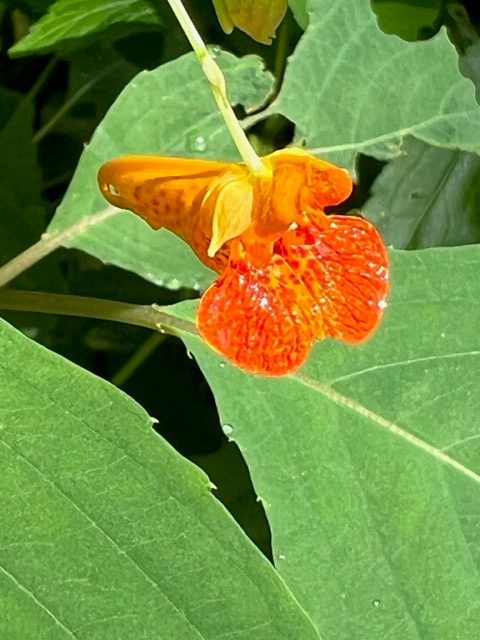Native Wildflowers: Jewels of the Summer

During this season of fireworks, we often don’t think of a plant behaving like the nighttime spectacles. But jewelweed, also known as touch-me-not (Impatiens capensis) does just that.
The seed pods for the plant resemble bananas, and when the seeds are ripe, the slightest touch will send the seeds inside flying 4 inches to 5 inches away! The pods are designed with plant structures that look and act like coils that expand and contract when touched. This action splits apart the covering and the seeds go flying.
The nature interpreters at Farbach-Werner Nature Preserve demonstrate just how slight of a touch it takes to send jewelweed seeds flying.
What’s in a Name?
That’s not the only amazing thing about this plant. It gets its other common name, jewelweed, for a couple of different reasons. One is that the blossoms hang down below the leaves and reminds people of dangling earrings. Another reason for the name is the way water or dew reacts with the leaves: When water pours off the leaves, it looks almost like molten silver. And when the dew or raindrops collects on the leaves, they sparkle like diamonds.
Habitat
This annual native wildflower likes to grow in wet, shaded areas. They can often be found near creeks and streams and wet woodlands. Jewelweed typically grows 3 to 5 feet in height and is thick stemmed. The sap of this plant is very juicy and for some, it helps to relieve the pain and itch from poison ivy.
A Favorite of Pollinators


You may be able to see both the yellow and orange jewelweed blossom varieties along Great Parks trails. The Trout Lily Trail at Withrow Nature Preserve is a great place to spy wildflowers while on a hike.
Jewelweed has two distinct types of blossoms: the yellow touch-me-not and the orange, or spotted, touch-me-not. They are a favorite food source for hummingbirds, as the shape of the flower seems to be particularly suited for their long beaks and tongues.
Since jewelweed blooms all summer long and into the early fall, it’s a great resource for fuel when hummingbirds are getting ready to make the long migration south.
On your next walk along a Great Parks trail, be on the lookout for this wonderful plant. Maybe you’ll even get really lucky and see a hummingbird catching a quick meal too!
—
Amy Roell
Director of Programming

